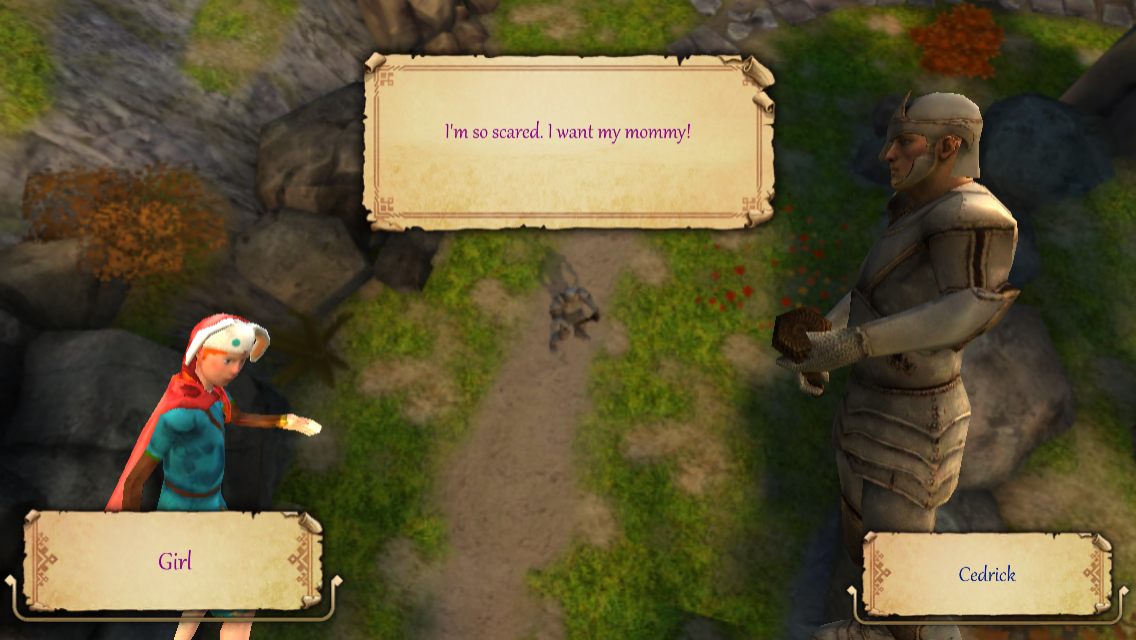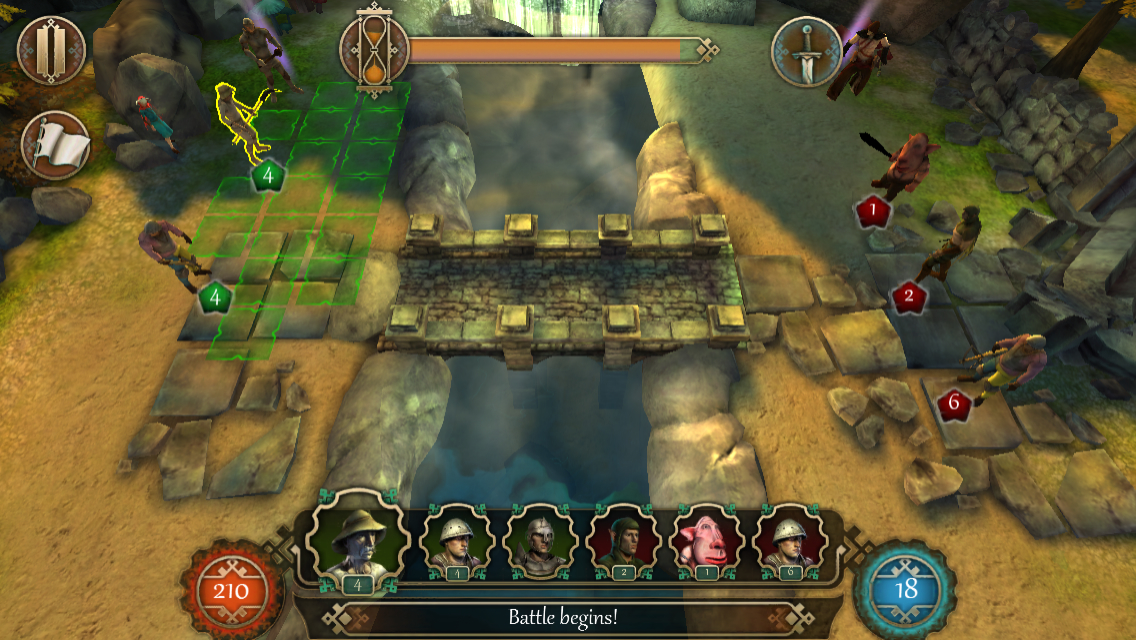 Developer Jujubee is probably most famous in the iOS scene for the Flashout series, their entry into the high-speed futuristic racing sub-genre. They’re stylish games that don’t venture all that far from the template, and at least at the time of the respective releases of each, satisfied a relatively underserved niche in the mobile gaming scene. Their latest effort wades into more populated waters, the RPG genre. Spellcrafter: The Path Of Magic ($0.99) is an odd hybrid. The battles play out like a light strategy RPG, but the parts between fights allow you to wander around like a more standard top-down RPG. Even more strangely, the game has a level-based setup, with three different playable heroes each getting three stages. Everything is okay on paper, but it just doesn’t come together well at all.
Developer Jujubee is probably most famous in the iOS scene for the Flashout series, their entry into the high-speed futuristic racing sub-genre. They’re stylish games that don’t venture all that far from the template, and at least at the time of the respective releases of each, satisfied a relatively underserved niche in the mobile gaming scene. Their latest effort wades into more populated waters, the RPG genre. Spellcrafter: The Path Of Magic ($0.99) is an odd hybrid. The battles play out like a light strategy RPG, but the parts between fights allow you to wander around like a more standard top-down RPG. Even more strangely, the game has a level-based setup, with three different playable heroes each getting three stages. Everything is okay on paper, but it just doesn’t come together well at all.
Like almost every RPG, there’s a story here. This one centers around a young, amnesiac mage who represents the last hope for the world. You guide three different heroes as they try to help this mage reach her full potential, protecting her from the nasty bad guys out to get her. There are occasional opportunities for dialogue choices that seem to affect subsequent conversations, but I’ll be gentle and say that the text isn’t Spellcrafter‘s strong point. The English seems to be written by a non-native speaker, which certainly doesn’t help, but the bigger problem is just how generic and utterly unimportant it all is. Well, I guess that wasn’t very gentle after all, but that’s how it is.
I’m not going to try to mislead you here, friends. I don’t like Spellcrafter very much. I don’t think any part of it works as well as it needs to. The levels are largely linear affairs with little in the way of secrets to find. Your choices amount to whether or not you want to challenge every battle between you and the treasure chests, but as the old saying goes, you can’t take it with you. Every level is more or less a blank slate, save your character’s level, so accumulating wealth or a powerful army does nothing for you beyond the immediate challenge. Doing as many fights as you can at least ensures your main character’s level is as high as it could be, but once you’re past the first couple of stages, you really need to pick your fights lest you be left with too few resources to win the level’s final battle. If that happens, you’ll have to restart the stage from scratch. I can see why it resets your army and gold after each level, as it probably made for easier balancing and guarantees each level is winnable for every player, but it certainly takes the wind out of exploring.
It’s still important to nab all that gold, though. You’ll need it to hire your army, since you are but a squishy mage. As you progress through each stage, you’ll find NPCs that will hook you up with soldiers for the right price. Each character has access to different troop types, so you do get a bit of variety with each stage set. Your ability to complete each stage is heavily contingent on having enough soldiers stockpiled. The enemy groups are fixed, so what you bring into the fight with you is the heaviest determiner of the outcome. If you lose too many troops in a fight, you’ll probably want to retry the fight or retreat altogether. The gold in each stage is finite, so you can’t afford to take heavy losses.
The battles are another misfire. You’ll face off against the enemies in a grid-based arena of sorts. When your character’s turn comes up, you’ll have a limited amount of time to input a command. The longer you take to think, the weaker your attack will be. Each troop type has their own patterns of movement and attack, as well as special abilities that you can unlock by leveling up the appropriate stat. Annoyingly, once you’ve made a move, there’s no confirmation and no taking it back, so a mistouch can be disastrous. While the arenas are fairly small, they’re divided up into quite a number of grid spaces. If you’re playing on a smaller screen, it’s easy to tap the wrong square and waste a character’s turn. Since all of the units of one type stack in battles, a wasted turn is basically losing at least a quarter of your moves for the round.
When your main character’s turn comes up, you can cast a spell. This requires drawing a shape with your finger, which is novel at first but wears out its welcome fast. If you have the shape memorized, you can just fire away and get the maximum results, but if you don’t, you’ll have to open up your spellbook and check it. Even with the shape in mind, the game doesn’t always recognize what you’re drawing, so you might have to try a couple of times. The clock ticks down all the while, reducing the effectiveness of whatever you’re trying to do. More than anything, it reminds me of drawing seals in Castlevania: Dawn Of Sorrow. That’s not a pleasant memory for me or most anyone else, I fear.
After the battle finishes, you’ll be given a star ranking and awarded experience points. Should you level up, you’ll get a point that you can put into one of three categories, each with various abilities you can unlock at certain levels. Specialization seems to be the wise strategy here. The finite number of encounters on each stage acts as an effective level cap. This is probably the only way you can really paint yourself into a corner in Spellcrafter. If you don’t level up enough in the first two stages for each character, you may not be strong enough to survive the third. Coupled with each stage’s limited resources all around, this makes the levels more of a puzzle than most other RPGs. You need to figure out which battles to do in which order, which troops to hire with your gold, and what you consider acceptable losses for moving forward. After finishing each battle you have the option to try it again from the start, and running away at any time during the fight costs you nothing. You’ll simply appear back on the map in the state you were in prior to the fight.
Jujubee made a good effort with the presentation. From a distance, everything looks really good. When you get up close to the character models they’re not quite as pleasing to the eye, especially the terrible faces. That said, you’re only up close during conversations, when you should just be hammering the screen to get past through as fast as possible anyway. The sound effects are alright and the music is decent but gets old fast. The voice clips when your character casts a spell are hilarious, but I don’t think they’re supposed to be. I should also mention that if you’re not running the latest hardware, Spellcrafter has some performance issues. Even on my iPhone 5S, the overworld was stuttering badly almost all the time. It also turned my phone into a tiny sun almost certainly capable of heating a one-bedroom apartment in a Winnipeg winter.
Simply put, Spellcrafter wasn’t a fun experience for me. I think the stage-based set-up is interesting, and I like that there are three characters each with their own troop types and skills. Unfortunately, the levels themselves aren’t very satisfying to explore, and the battle system that sits at the heart of the game is just unpleasant. The enemy AI is predictable, the terrain has little variety, the hits lack impact, and the spell-casting system wears thin in a hurry. Too much of a battle’s outcome has little to do with your actual strategy, instead relying on having the right numbers and nimble, accurate fingers. The more I played this game, the less I liked it. With tons of great choices in the strategy RPG genre on iOS, there’s little reason to spend your time or money on this.



